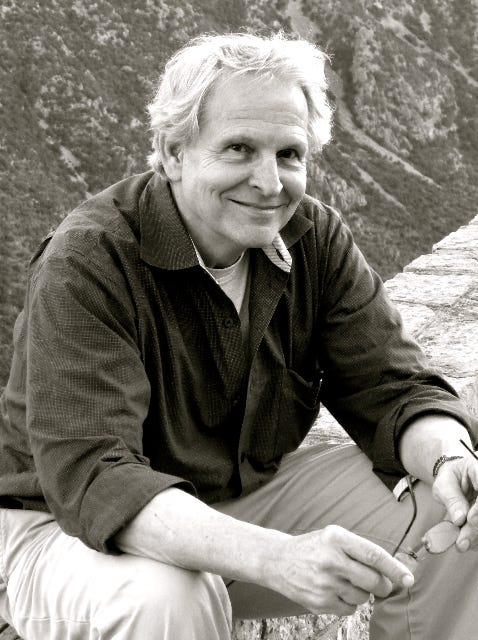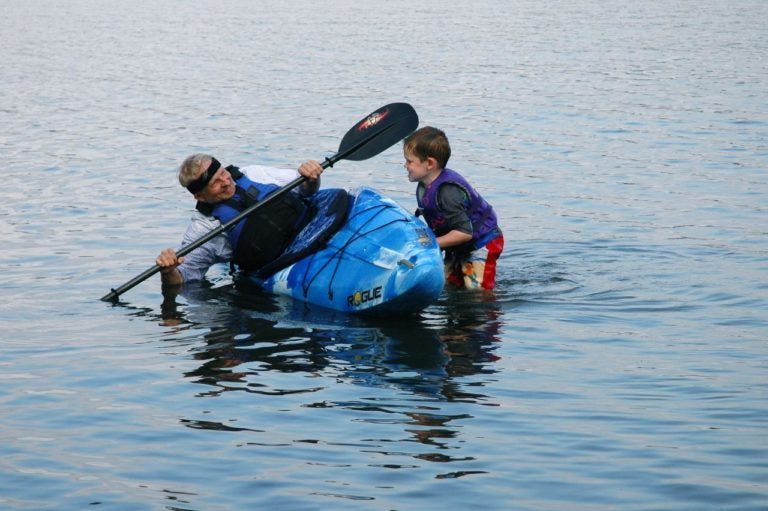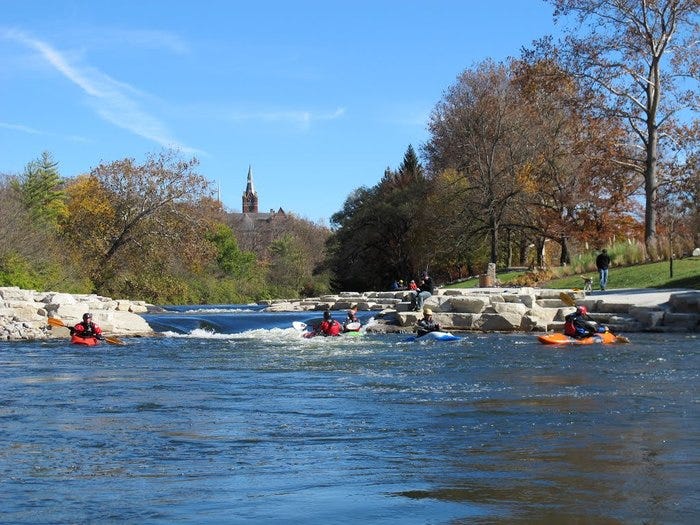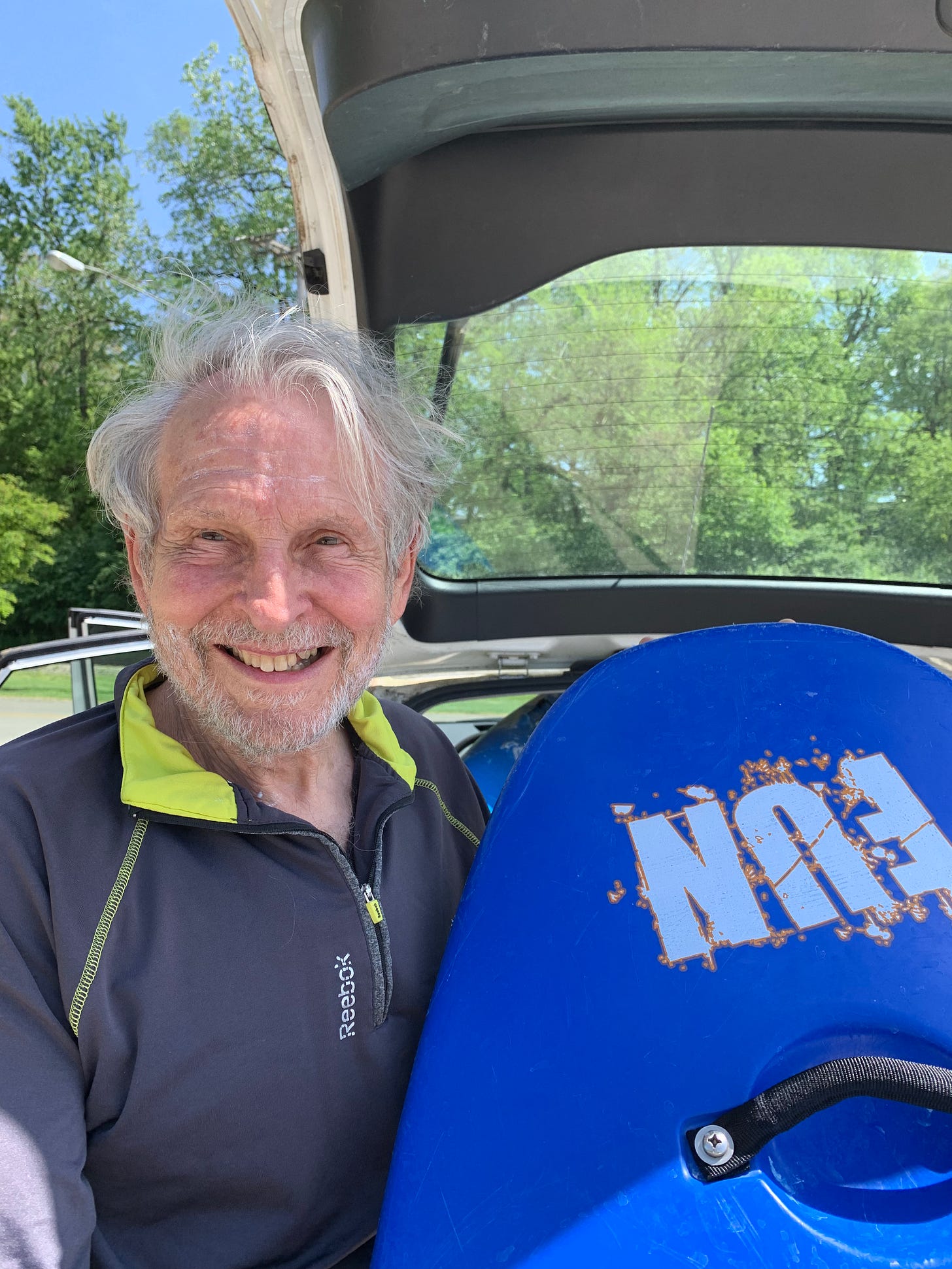
Once upon a time, in the deep woods of western Maine, Kent Dixon climbed into a kayak and eagerly set off across Kezar Lake, hoping to bump into Stephen King. He remembers the loons laughing and diving and the sound of the cool, fresh water as he paddled. It was fall. He was 60 years old and on sabbatical. Life was sweet.
The day had a certain auspicious aura to it, the sense that something big was waiting on the far shore in all that dappled sunlight. Bespectacled novice paddler; short story writer; beloved, goofy teacher taking a spur-of-the-moment kayak trip—what could possibly go wrong?
He didn’t meet up with the storied novelist, who lived at the northern end of the lake, but he did have an intense encounter with an aggressive bull moose, who bellowed at Kent when he accidentally drifted into the animal’s personal cove. Kent quickly backpaddled away from the angry moose, delivering silent mea culpas in retreat. Terror, wonder, the rush of adrenaline: like a Stephen King story, things could’ve gone terribly wrong on that crystalline day, but then, like a meandering river, the story turned.
Sabbatical over, Kent and his wife, Mimi, also an English professor, stashed the kayak on the back porch of the cabin they’d borrowed from a colleague, locked the door and went home, to Springfield, Ohio.
For the Dixons, Springfield had been an odd place to wash ashore. Mimi grew up next to Chicago’s Lake Michigan, where her dad, Ray Still, was a famous oboist with the Chicago Symphony Orchestra. As for Kent, an only child, he grew up on Miami’s Biscayne Bay with socialite parents he describes as “party animals.”
“I remember police arriving at our larger parties, responding to neighborhood noise complaints, and before you knew it, they were walking around in shirt sleeves carrying their own drinks, letting me handle their guns,” he writes. With his parents in a celebratory mode, Kent ran amok on wild, magical Biscayne Bay, exploring in an eight-foot pram with a 3.5 horsepower outboard motor, the 400 square miles of mangroves, coral reefs, shallows and currents. Years later, Kent and Mimi met in Iowa City, where Kent was getting his Ph.D. from the University of Iowa and Mimi was running a private elementary school she’d co-founded. They married and came to Springfield’s Wittenberg University to teach English in 1980.

Springfield is a small, blue-collar city surrounded by lush fields of corn and soybeans. In his essay, “The Veins of The Planet,” Kent recalls feeling frustrated and landlocked by those early Ohio years, teaching at a small liberal arts college and itching for the excitement of big water. “There’s no Lake Erie nearby to ameliorate the situation, and when I first got here,” he writes, “I used to drive out to the Reservoir at night to watch the moon ripple on its water and kick sand along that excuse for a beach, listening, smelling, feeling very unresolved about the prospect of being dry-docked for the next 30 years.”
Ohio is not exactly the Mojave Desert through. This green, wet state is rife with wetland ecosystems, from common marshes and swamps in the northern part of the state to less common fens and bogs. Rivers big and small criss-cross the Buckeye State. In the west central part of Ohio, where Kent and I live, the Mad River flows past Springfield, where it’s joined by Buck Creek, which flows through downtown and is part of the city’s park system.
In an earlier life, Buck Creek, just like Springfield, had been lively and robust. But over the years, it became sluggish and filled with unsightly debris like tires and discarded shopping carts. The creek’s flow and vitality was also hampered by hazardous, low-head dams, making it largely unnavigable.
Years went by. Kent and Mimi’s four kids grew up and moved away. The kitchen was renovated. A grandchild was born. Kent’s mom died. Mimi got cancer, then recovered. Kent continued to teach and publish stories in literary magazines, won prizes, mentored students. (For more of Kent’s writing: www.kenthdixon.com ) The shoreline kept changing. The closest he got to water was knocking out boring laps in the university pool. That auspicious, hopeful day on the lake in Maine was far away.
Then, an unexpected thing happen. When Springfield native John Loftis returned after years of living in Steamboat Springs, Colo., where whitewater was abundant, he realized he’d been spoiled by that sporting epicenter. In Ohio, the closet place for whitewater kayaking was hours away, in West Virginia. If Loftis wanted whitewater in Springfield, he’d have to make it happen himself. That was fourteen years ago.
Working with the U.S. Army Corps of Engineers and the city’s conservancy project, Loftis and others came up with a plan to flush out Buck Creek’s low-head dams, clear the banks and build terracing that provided access right to the edge of the creek. It was an arduous project, filled with governmental tedium and endless red tape. Environmental studies, permits, water quality monitoring stations—like the establishment of special eddies for the breeding of a rare guppy—all of it took a long time. But the end result was a huge win for Springfield and boaters.
“We have eight of those frothy silver drops now, creating several miles of ever-changing landscape—wild and woody, industrial, commercial; bicycle paths, baseball stadium, vintage bridges from the 1920s and highway overpasses; a picturesque railroad trestle overhead, some charming rapids, a drive-through bar overlooking the river which could be a paddle-through overlooking the river if they’d listen to me, though you don’t really want to be drinking much besides water out on our Class II+/Class III- Buck Creek,” Kent writes.
Springfield now has its own downtown ECO Sports Corridor on Buck Creek. In recent years, it’s become a popular destination for boaters, a place for beginners to learn how to navigate in moving water, and for more advanced kayakers to practice fancy strokes and rolls. It’s Whitewater 101.
As for Kent, he’s become a water nerd, or, in his words, “a river fancier.” In his ninth decade he’s delighted to discover that he loves rivers, even more than he loved his beloved Biscayne Bay, that watery place of childhood escape. Kayaking “just fills and closes a gap I felt forever,” he says.
Although Kent retired from teaching at Wittenberg in 2013, he still teaches a summer course on creative writing and kayaking, “Rivers: Reading, Writing, and Running Them.” He’ll be 82 next month but when he talks about kayaking, he’s as giddy as a kid with a Taylor Swift ticket.
You should hear him talk: the boils, the pillows, the rooster tails and haystacks, the eddies and drops and holes. Don’t get him started; he’ll rhapsodize all day about the mythic way his kayak makes him feel, sitting in it, low in the water, half-man, half-boat, a centaur with paddle-arms.
“I love the passing scenery, like a kinescope, the river banks sometimes downright industrial as you slide past a factory, some defunct and abandoned but some still churning away, churning out their whatever (often as not right into the river!); but other times, same river, you get something out of Heart of Darkness,” Kent writes in “Obsession: [X] Kayak.”
Kayaking through Springfield isn’t as dramatic as paddling on a lake in the Maine wilderness populated with moose and laughing loons, but there are intimate, surprising moments to be had here in the city. Kent recalls cruising down Buck Creek with friends and seeing a family of deer—a doe, a yearling, and a baby fawn.
“Mother and teenager loped across in graceful leaps, but along came baby, not tall enough yet, and on his last heap he disappeared nose first into the deepest part, almost to the bank but completely under,” Kent writes. “We’re watching. The doe on a slight rise above us turns her head and patiently looks back—God, that was beautiful—and up comes Bambi’s head and then the rest of him, scrambling up onto the bank and hurrying on to the mother, who noses him once and then they turn and disappear into the woods. At that point the three of us had reached abreast of the action and passed on by. Here’s the thing: we drifted on, stroking mildly for at least a hundred yards before any of us said anything. You don’t clap in church.”
And if, entranced by the scenery and wildlife, Kent loses his shit, and the kayak starts rolling like an alligator doing its awful death roll, don’t worry. He knows what to do: “bite your jacket.” Translation: your head should be the very last thing to enter the confines of the cockpit as you come up from a roll.
“It’s so counter-intuitive,” he says. “Like life.” (He’s so smitten by that phrase that he thinks he might have it inscribed on his headstone. He wants to be buried on the banks of Buck Creek, where this late-life watery romance is happening.)

If you come to Springfield this summer, stop by the waterpark on Buck Creek (it’s not far from the dog park in Snyder Park.) Chances are you’ll see a silver-haired man in a sleek blue-and-white Pyranha Fusion, which he’s named “Baby Blue” after the Dylan song, “And It’s All Over Now, Baby Blue.”
About the true meaning of the song, Kent writes: “No-one knows what that song is about—Dylan is saying good-bye in 1965 to Joan Baez? or to acoustic guitar? or David Blue or someone else, but come on, just listen to the words:
‘The high way is for gamblers, better use your sense.
Take what you have gathered from coincidence.
This sky, too, is folding under you
And it’s all over now, Baby Blue.’
“You tell me that’s not about kayaking?”





What a poetic essay - "low in the water, half-man, half-boat, a centaur with paddle-arms". I loved reading this piece. I have yet to kayak this creation of a river, but I am determined to now. This summer. Thank you for sharing your magic, D'Arcy - and that of Dylan and Dixon.
What a treat to read your writing and lean into your state! Makes me want to come visit! 😊❤️